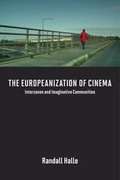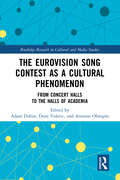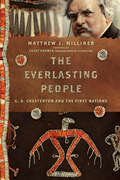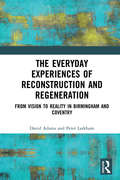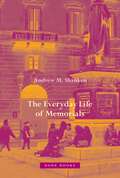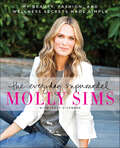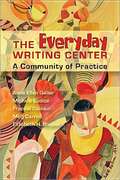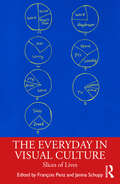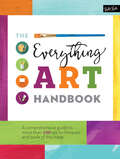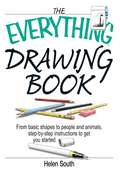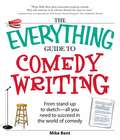- Table View
- List View
The Europeanization of Cinema: Interzones and Imaginative Communities
by Randall HalleIn this innovative study, German and film studies scholar Randall Halle advances the concept of "interzones"--geographical and ideational spaces of transit, interaction, transformation, and contested diversity--as a mechanism for analyzing European cinema. He focuses especially on films about borders, borderlands, and cultural zones as he traces the development of interzones from the inception of central European cinema to the avant-garde films of today. Throughout, he shows how cinema both reflects and engenders interzones that explore the important questions of Europe's social order: imperialism and nation-building in the late nineteenth and early twentieth centuries; "first contact" between former adversaries (such as East and West Germany) following World War II and the Cold War; and migration, neo-colonialism, and cultural imperialism in the twenty-first century. Ultimately, Halle argues that today's cinema both produces and reflects imaginative communities. He demonstrates how, rather than simply erasing boundaries, the European Union instead fosters a network of cultural interzones that encourage cinematic exploration of the new Europe's processes and limits of connectivity, tolerance, and cooperation.
The Eurovision Song Contest as a Cultural Phenomenon: From Concert Halls to the Halls of Academia (Routledge Research in Cultural and Media Studies)
by Antonio ObregónDrawing from the wealth of academic literature about the Eurovision Song Contest (ESC) written over the last two decades, this book consolidates and recognizes the ESC's relevance in academia by analysing its contribution to different fields of study. The book brings together leading ESC scholars from across disciplines and from across the globe to reflect on the intersection between their academic fields of study and the ESC by answering the question: what has the ESC contributed to academia? The book also draws from fields rarely associated with the ESC, such as Law, Business and Research Methodologies, to demonstrate the contest's broad utility in research, pedagogy and in practice. Given its interdisciplinary approach, this volume will be of interest to scholars and students working in cultural, media, and music studies, as well as those interested in the intersections between these areas and politics, law, education, pedagogy, and history.
The Everlasting People: G. K. Chesterton and the First Nations (Hansen Lectureship Series)
by Matthew J. MillinerFirst Things Book of the Year award What does the cross of Christ have to do with the thunderbird? How might the life and work of Christian writer G. K. Chesterton shed light on our understanding of North American Indigenous art and history? This unexpected connection forms the basis of these discerning reflections by art historian Matthew Milliner. In this fifth volume in the Hansen Lectureship Series, Milliner appeals to Chesterton's life and work—including The Everlasting Man, his neglected poetry, his love for his native England, and his own visits to America—in order to understand and appreciate both Indigenous art and the complex, often tragic history of First Nations peoples, especially in the American Midwest. The Hansen Lectureship series offers accessible and insightful reflections by Wheaton College faculty on the transformative work of the Wade Center authors.
The Everyday Experiences of Reconstruction and Regeneration: From Vision to Reality in Birmingham and Coventry
by David Adams Peter LarkhamSet within a wider British and international context of post-war reconstruction, The Everyday Experiences of Reconstruction and Regeneration focuses on such debates and experiences in Birmingham and Coventry as they recovered from Second World War bombings and post-war industrial collapse. Including numerous images, Adams and Larkham explore the initial development of the post-Second World War reconstruction projects, which so substantially changed the face of the cities and provided radical new identities. Exploring these cities throughout the post-war period brings into sharp focus the duality of contemporary approaches to regeneration, which often criticise mid-twentieth century ’poorly-conceived’ planning and architectural projects for producing inhuman and unsympathetic schemes, while proposing exactly the type of large-scale regeneration that may potentially create similar issues in the future. This book would be beneficial for academics and students of planning and urban design, particularly those with an interest in post-catastrophe or large-scale reconstruction projects within cities.
The Everyday Life of Memorials
by Andrew M. ShankenA timely study, erudite and exciting, about the ordinary—and oftentimes unseen—lives of memorialsMemorials are commonly studied as part of the commemorative infrastructure of modern society. Just as often, they are understood as sites of political contestation, where people battle over the meaning of events. But most of the time, they are neither. Instead, they take their rest as ordinary objects, part of the street furniture of urban life. Most memorials are “turned on” only on special days, such as Memorial Day, or at heated moments, as in August 2017, when the Robert E. Lee monument in Charlottesville was overtaken by a political maelstrom. The rest of the time they are turned off. This book is about the everyday life of memorials. It explores their relationship to the pulses of daily life, their meaning within this quotidian context, and their place within the development of modern cities. Through Andrew Shanken’s close historical readings of memorials, both well-known and obscure, two distinct strands of scholarship are thus brought together: the study of the everyday and memory studies. From the introduction of modern memorials in the wake of the French Revolution through the recent destruction of Confederate monuments, memorials have oscillated between the everyday and the “not-everyday.” In fact, memorials have been implicated in the very structure of these categories. The Everyday Life of Memorials explores how memorials end up where they are, grow invisible, fight with traffic, get moved, are assembled into memorial zones, and are drawn anew into commemorations and political maelstroms that their original sponsors never could have imagined. Finally, exploring how people behave at memorials and what memorials ask of people reveals just how strange the commemorative infrastructure of modernity is.
The Everyday Supermodel: My Beauty, Fashion, and Wellness Secrets Made Simple
by Molly Sims Tracy O'ConnorWith down-to-earth charm, humor, and best-girlfriend tough love, supermodel next door Molly Sims shares her hard-earned beauty, fashion, fitness, and health secrets in this fully illustrated four-color guide.Molly Sims wasn’t born looking the way she does on television and in print. Like all of us, she’s had bad hair days, weight issues, skin problems, career setbacks, and fashion disasters. The secret to her seemingly perfect supermodel look and confidence? She works hard to look good . . . and she’s tried everything,In this fun and practical guide, Molly interweaves stories from her life with her own tried-and-true tips, as well as advice from the best in the business of beauty, health, fitness, and fashion. The ultimate guinea pig when it comes to looking good and feeling good, she’s learned what works—and what doesn’t—and is prepared to share it all with women everywhere.Not afraid to dish on herself, Molly breaks down her personal weight loss strategies, anti-aging secrets, style advice, and so much more. Filled with insider secrets, easy to follow hair and makeup tutorials, on-the-go workouts, healthy recipes, and look good/feel good advice, it truly is a Hollywood tell-all! The Everyday Supermodel is guaranteed to transform the everyday woman into the very best version of herself.
The Everyday Writing Center
by Meg Carroll Anne Ellen Geller Elizabeth H. Boquet Frankie Condon Michele EodiceThe Everyday Writing Center challenges some of the most comfortable traditions in its field, and it does so with a commitment and persuasiveness that one seldom sees in scholarly discussion. The book, at its core, is an argument for a new writing center consciousness--one that makes the most of the writing center's unique, and uniquely fluid, identity. Writing center specialists live with a liminality that has been acknowledged but not fully explored in the literature. Their disciplinary identity is with the English department, but their mission is cross-disciplinary; their research is pedagogical, but they often report to central administration. Their education is in humanities, but their administrative role demands constant number-crunching. This fluid identity explains why Trickster--an icon of spontaneity, shape-shifting, and the creative potential of chaos--has come to be a favorite cultural figure for the authors of this book. Adapting Lewis Hyde and others, these authors use Trickster to develop a theme of ordinary disruptions ("the everyday") as a source of provocative learning moments that can liberate both student writers and writing center staff. At the same time, the authors parlay Etienne Wenger's concept of "community of practice" into an ethos for a dynamic, learner-centered pedagogy that is especially well-suited to the peculiar teaching situation of the writing center. Through Trickster, they question not only accepted approaches to writing center pedagogy, but conventional approaches to race, time, leadership, and collaboration as well. They encourage their field to exploit the creative potential in ordinary events that are normally seen as disruptive or defeating, and they challenge traditions in the field that tend to isolate a writing center director from the department and campus. Yet all is not random, for the authors anchor this high-risk/high-yield approach in their commitment to a version of Wenger's community of practice. Conceiving of themselves, their colleagues, student writers, and student tutors as co-learners engaged together in a dynamic life of learning, the authors find a way to ground the excess and randomness of the everyday, while advancing an ethic of mutual respect and self-challenge. Committed to testing a region beyond the edge of convention, the authors of The Everyday Writing Center constantly push themselves and their field toward deeper, more significant research, and more reflective, dynamic teaching.
The Everyday in Visual Culture: Slices of Lives
by François Penz Janina SchuppThis book explores how the comparative analysis of visual cultural artefacts, from objects to architecture and fiction films, can contribute to our understanding of everyday life in homes and cities around the globe. Investigating the multiple facets of the everyday, this interdisciplinary collection generates a new awareness of everyday lives across cultures and challenges our traditional understanding of the everyday by interweaving new thematic connections. It brings together debates around the analysis of the everyday in visual culture more broadly and explores the creation of innovative technological methods for comparative approaches to the study of the everyday, such as film databases, as well as the celebration of the everyday in museums. The volume is organized around four key themes. It explores the slices of everyday lives found in Visual Culture (Part I), Museums (Part II), the City (Part III) and the Home (Part IV). The book explores the growing area of the analysis of everyday life through visual culture both broadly and in depth. By building interdisciplinary connections, this book is ideal for the emerging community of scholars and students stemming from Visual Culture, Film and Media Studies, Architecture Studies and practice, Museum Studies, and scholars of Sociology and Anthropology as well as offering fresh insights into cutting-edge tools and practices for the rapidly growing field of Digital Humanities.
The Everything Aquarium Book: All You Need to Build the Acquarium of Your Dreams
by Frank IndiviglioA Simon & Schuster eBook. Simon & Schuster has a great book for every reader.
The Everything Art Handbook: A Comprehensive Guide to More Than 100 Art Techniques and Tools of the Trade
by Walter Foster Creative TeamPick up your pencil or brush and start creating with this go-to resource for artists of all skill levels, covering drawing, painting, and mixed media.A refreshing, accessible compendium of art materials and techniques, The Everything Art Handbook is the perfect all-inclusive resource for beginning artists wanting to experiment and play with a variety of art mediums and techniques.The Everything Art Handbook is divided into sections focusing on different types of mediums and art concepts. Each section includes a basic overview of the topic, instructions for selecting and working with the right tools and materials, step-by-step sample artwork, and helpful sidebars with advice from professional artists.Expand and refresh your artistic skills with such topics as:Getting started, including how to set up a studio and where to find inspirationArt fundamentals, such as value and light, perspective, and compositionColor basics, including complementary colors, primaries, secondaries, and neutralsDrawing techniques for working with graphite, charcoal, colored pencil, pastel, pen and ink, and morePainting techniques for working with oil, acrylic, and watercolorMixed media tools and techniques, including stamping, encaustics, and texturesUsing clear, informative explanations for achieving the best results, The Everything Art Handbook is an approachable reference guide for contemporary artists of any skill level.
The Everything Candlemaking Book: Create Homemade Candles in House-Warming Colors, Interesting Shapes, and Appealing Scents (Everything® Series)
by Marie-Jeanne AbadieNow, with The Everything Candlemaking Book, you can enjoy the charm of candles every day, rather than reserve them only for holidays or fancy dinner parties. Home candlemaking is not only much more economical than buying premade candles--it's also a lot more fun! The Everything Candlemaking Book is a complete guide to making all kinds of candles at home, beginning with what you need to get started. Easy-to-follow steps lead you through the process of candlemaking--from making simple tapers and columns to layered, moulded, twisted, and more. Beautiful full-color photographs provide inspiration for creativity, whether you're designing your own unique shapes and color combinations or attempting advanced techniques.This guide includes all you need to know to get started:tools and supplies neededinstructions on how to make candles for holidays and special occasionsartistic techniques, such as chip, twisted, and applique candlesguidance on using unique containerstips on how to incorporate candles into ritualshints on adding scents and personal touches to your candlesand so much more!With The Everything Candlemaking Book, you'll be making homemade candles for yourself and your friends in no time!
The Everything Cartooning Book: Create Unique And Inspired Cartoons For Fun And Profit (Everything® Series)
by Brad J GuigarNo matter what your background, The Everything Cartooning Book is the all-in-one reference to unlock your hidden potential and set you on the fast track toward a rewarding career in cartooning. Professional cartoonist Brad J. Guigar shows you everything from how to create believable characters and effective story lines to writing humor and getting published. This step-by-step guide shows you all the insider techniques and tricks you need to make it in this fun and creative field.Features tips on how to:Show movementCreate cartoons for different genresDevelop your individual styleCraft story linesSell your workand moreWhether you like to draw Manga, create humorous animal characters, or satirize the world around you, The Everything Cartooning Book teaches you all you need to know to successfully follow your artistic dreams.
The Everything Coin Collecting Book
by Richard GiedroycAre you one of the 125 million coin collectors in the United States? Whether you're a beginner or an avid collector,The Everything Coin Collecting Bookis your accessible reference for this exciting and profitable hobby. Written by a well-known numismatic authority, this is only authoritative guide written in an approachable style for every reader. ReadThe Everything Coin Collecting Bookand you'll learn about: Starting and maintaining a collection Coin terminology Grading and authenticating coins Rarity and coin values Covering it all-from starting a collection, to selling and trading like a pro-this is the all-in-one guide you need to maintain a successful collection and trade for profit.
The Everything Coin Collecting Book
by Richard GiedroycAre you one of the 125 million coin collectors in the United States? Whether you're a beginner or an avid collector, The Everything Coin Collecting Book is your accessible reference for this exciting and profitable hobby. Written by a well-known numismatic authority, this is only authoritative guide written in an approachable style for every reader.Read The Everything Coin Collecting Book and you'll learn about: Starting and maintaining a collection Coin terminology Grading and authenticating coins Rarity and coin values Covering it all-from starting a collection, to selling and trading like a pro-this is the all-in-one guide you need to maintain a successful collection and trade for profit.
The Everything Coin Collecting Book: All You Need to Start Your Collection And Trade for Profit
by Richard GiedroycAre you one of the 125 million coin collectors in the United States? Whether you're a beginner or an avid collector, The Everything Coin Collecting Book is your accessible reference for this exciting and profitable hobby. Written by a well-known numismatic authority, this is only authoritative guide written in an approachable style for every reader.Read The Everything Coin Collecting Book and you'll learn about:Starting and maintaining a collectionCoin terminologyGrading and authenticating coinsRarity and coin valuesCovering it all-from starting a collection, to selling and trading like a pro-this is the all-in-one guide you need to maintain a successful collection and trade for profit.
The Everything Da Vinci Book
by Cynthia Phillips Shana PriwerWhatever you've heard about Leonardo Da Vinci, the truth is even more fascinating! From his provocative relationship with the church and secret societies such as the Freemasons to the secrets behind his art and inventions, Da Vinci was a man ahead of his time who willingly paid the price to live life his way. This multitalented man, arguably the greatest genius of all time, was not only a magnificent artist, scientist, and inventor, but also a politically-minded radical who defied convention at every turn in his rich, amazing life. WithThe Everything Da Vinci Book, you'll immerse yourself in the extraordinary mind, heart, and soul of this quintessential Renaissance man, and be inspired to live your own life to the fullest!
The Everything Da Vinci Book
by Cynthia Phillips Shana PriwerWhatever you've heard about Leonardo Da Vinci, the truth is even more fascinating! From his provocative relationship with the church and secret societies such as the Freemasons to the secrets behind his art and inventions, Da Vinci was a man ahead of his time who willingly paid the price to live life his way. This multitalented man, arguably the greatest genius of all time, was not only a magnificent artist, scientist, and inventor, but also a politically-minded radical who defied convention at every turn in his rich, amazing life. With The Everything Da Vinci Book, you'll immerse yourself in the extraordinary mind, heart, and soul of this quintessential Renaissance man, and be inspired to live your own life to the fullest!
The Everything Da Vinci Book: Explore the Life and Times of the Ultimate Renaissance Man
by Cynthia Phillips Shana PriwerReaders will learn everything they didn't know about the quintessential Renaissance Man, the easy "Everything" way.
The Everything Da Vinci Book: Explore the life and times of the Ultimate Renaissance Man
by Shana PriwerWhatever you've heard about Leonardo Da Vinci, the truth is even more fascinating! From his provocative relationship with the church and secret societies such as the Freemasons to the secrets behind his art and inventions, Da Vinci was a man ahead of his time who willingly paid the price to live life his way. This multitalented man, arguably the greatest genius of all time, was not only a magnificent artist, scientist, and inventor, but also a politically-minded radical who defied convention at every turn in his rich, amazing life. With The Everything Da Vinci Book, you'll immerse yourself in the extraordinary mind, heart, and soul of this quintessential Renaissance man, and be inspired to live your own life to the fullest!
The Everything Digital Photography Book (Second Edition)
by Ric DeGaris DobleWith a snap of the shutter and a couple clicks of the mouse, you can take stunning photos and share them with the world. Digital photography is one of the easiest art forms to master-if you only know how.The Everything Digital Photography Book, 2nd Edition, has everything you need to take full advantage of this evolving art form. Learn how to: Choose the perfect camera, Use light and flashes for optimum effect, Download and transfer images, Compress images and post photos online, Create personalized gifts like calendars. Whether you're a novice photographer or a budding professional, this indispensable guide shows you how to capture the perfect shot-every time!
The Everything Drawing Book
by Helen SouthIf you've always wanted to draw but didn't think you had the talent, think again! With The Everything Drawing Book as your guide, you'll learn how to see the world through an artist's eyes-and capture it on canvas. Unlock your creative potential and expand your drawing expertise with:Useful exercises and assignments that help you find your own styleEasy tricks for charcoal, watercolor, and pen-and-ink methodsQuick tips on perspective and technique, as well as portraiture and landscape drawingBudget-friendly suggestions on how to save a bundle on expensive artist suppliesDozens of original drawings designed to spark your imagination And much, much more!
The Everything Drawing Book: From Basic Shape to People and Animals, Step-by-step Instruction to get you started
by Helen SouthIf you've always wanted to draw but didn't think you had the talent, think again! With The Everything Drawing Book as your guide, you'll learn how to see the world through an artist's eyes-and capture it on canvas. Unlock your creative potential and expand your drawing expertise with:Useful exercises and assignments that help you find your own styleEasy tricks for charcoal, watercolor, and pen-and-ink methodsQuick tips on perspective and technique, as well as portraiture and landscape drawingBudget-friendly suggestions on how to save a bundle on expensive artist suppliesDozens of original drawings designed to spark your imagination And much, much more!
The Everything Filmmaking Book: From Script to Premiere -a Complete Guide to Putting Your Vision on the Screen (Everything® Series)
by Barb Karg Rick Sutherland Jim Van OverFilmmaking is a notoriously difficult field to break into—a script&’s chance of making it to production is a staggering 1 in every 140,000. But the millions of aspiring filmmakers can up their odds with The Everything Filmmaking Book. This engaging, easy-to-follow guide takes readers step-by-step through the filmmaking process, including: -Writing a marketable script -Understanding all aspects of pre-production -Shooting on location -Working with the cast -Editing and post-production -Distributing the finished film The Everything Filmmaking Book is the perfect guide for future Spielbergs everywhere!
The Everything Guide to Comedy Writing (The Everything )
by Mike BentA guy walks into a bar...With this guide, aspiring comics will learn to navigate the complex world of comedy writing. Discover how to tap into your natural sense of humor through real-life examples and hands-on skill-building exercises. Learn the best ways to come up with ideas and write comedy that gets laughs--every time! Mike Bent, an accomplished stand-up comedian and teacher, provides the inside scoop on techniques to jump-start your comedy writing career, including how to:Develop comic characters for sketches and scenesCreate and polish a standup routineWrite for TV and moviesUse the web to advance your comedy careerEveryone loves a comedian. But breaking into this tough field is no laughing matter. After sharpening your comedy-writing skills with this practical (and funny!) guide, you'll feel comfortable adding humor to everyday situations and may even take a chance on your dream job in show business!
The Everything Guide to Selling Arts & Crafts Online: How to sell on Etsy, eBay, your storefront, and everywhere else online
by Kim SolgaYour guide to online success!Here's all you need to realize your dreams of turning your handiwork into cash--online! With the popularity of Etsy and Pinterest, serious art and craft buyers and sellers are turning to the online world to buy, sell, and promote beautiful, homemade creations...but where to start? This A-Z guide provides expert advice on building an online presence and getting your creations into the hands of buyers, including:Tips on creating a sound business plan.Techniques for writing effective copy and taking professional-level photographs.Help with creating a comprehensive marketing strategy.Ways to increase sales through online networking and social media.Best practices for accounting, packing, shipping, and customer service. You'll learn about the pros and cons of all the major art and craft sites, as well as tips for creating your own store online. With The Everything Guide to Selling Arts & Crafts Online, your online business can be up and running in no time!
